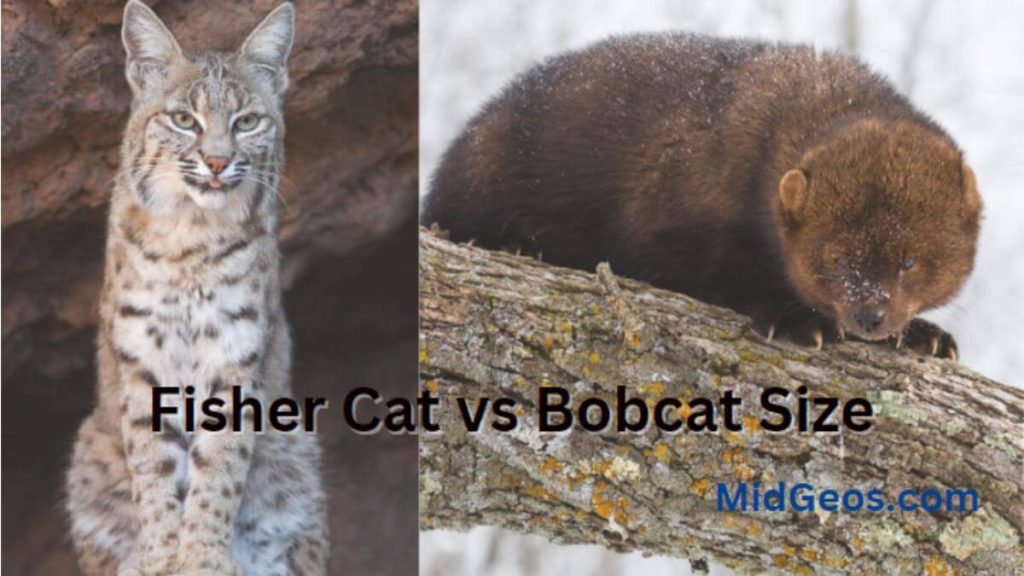Bobcat, Fisher Cat, Or Wild Cat – What’s Its Identity?

If you’re an outdoor enthusiast, you may have come across different types of wild cats in your adventures. From the bobcat to the fisher cat to the wild cat, these felines can be seen prowling the woods, hunting for prey, and exhibiting their impressive physical abilities.
However, do you know how to tell them apart? In this article, we will provide a comprehensive guide on how to distinguish Bobcat, Fisher Cat, Or Wild Cat – What’s Its Identity? Let me explain.
Bobcat Fisher Cat Or Wild Cat
Bobcat
Bobcats are one of the most common wild cats in North America. They are medium-sized felines that can grow up to 40 inches long and weigh up to 28 pounds. Bobcats have a distinct bobbed tail, hence their name, and tufted ears. Their fur is typically reddish-brown with black spots, making them well-camouflaged in their natural habitat.
Bobcats are solitary animals that are most active during dawn and dusk. They are skilled hunters and can take down prey up to twice their size, including deer, rabbits, and rodents. If you encounter a bobcat in the wild, it is best to keep your distance and not provoke them.
Fisher Cat
The fisher cat, also known as the fisher, is a member of the weasel family and is found in North America. Despite its name, fisher cats do not eat fish but are known for their predatory skills and ability to hunt a wide range of animals. They have a long, slender body, with dark brown fur and a bushy tail. Fisher cats have short legs and can move quickly and agilely through trees and over rough terrain.
Fisher cats are often mistaken for other wild cats, such as bobcats or minks, due to their similar appearance. However, their distinguishing feature is their loud screeching call, which can be heard from a distance. Fisher cats are mostly nocturnal and can be seen hunting for prey, including small mammals, birds, and reptiles.
Wild Cat
The term wild cat is used to describe any feline that is not domesticated and lives in the wild. This can include a variety of different species, such as the African wildcat, the European wildcat, and the Asian wildcat. These cats are typically larger than domestic cats and have a muscular build, sharp claws, and excellent hunting skills.
Wild cats can be difficult to spot in the wild as they are highly secretive and elusive. However, if you do come across one, it is important to exercise caution and avoid approaching them. Depending on the species, wild cats can range in size from small and agile to large and powerful.
Fisher Cat vs Bobcat
The fisher cat and the bobcat are both wild cats share some similarities, they have distinct physical characteristics and behaviors that set them apart. But they also have some differences. Here are some differnces between Bobcat and Fisher cat.
Physical Characteristics
One of the most noticeable differences between a fisher cat and a bobcat is their size. Fisher cats are smaller in size, weighing around 7-14 pounds, while bobcats can weigh up to 40 pounds. Fisher cats have long, slender bodies, short legs, and a bushy tail. Their fur is typically dark brown or black and has a thick, coarse texture.
On the other hand, bobcats are medium-sized with shorter tail and tufted ears. They have reddish-brown fur with black spots, which helps them blend in with their natural environment.
Habitat
Fisher cats and bobcats also have different habitat preferences. Fisher cats are found in forests, near streams, and wetlands. They prefer to live in areas with dense vegetation and are excellent climbers, which allows them to move quickly through trees.
Bobcats, on the other hand, can be found in various habitats, including forests, deserts, and swamps. They are adaptable animals and can survive in a range of environments.
Behavior
Another key difference between fisher cats and bobcats is their behavior. Fisher cats are mostly nocturnal and solitary animals. They are known for their high-pitched screeching call, which they use to communicate with other fisher cats.
Fisher cats are also skilled hunters and feed on a variety of prey, including rodents, small mammals, and birds.
Bobcats, on the other hand, are crepuscular, meaning they are most active during dawn and dusk. They are solitary animals and tend to avoid humans. Bobcats are skilled hunters and can take down prey up to twice their size. They feed on a variety of prey, including rabbits, deer, and rodents.
Interaction with Humans
Both fisher cats and bobcats can pose a threat to humans in certain situations. Fisher cats are known to attack domestic animals, such as chickens and small dogs. They can also become aggressive if cornered or provoked.
Bobcats, on the other hand, tend to avoid humans but can attack if they feel threatened. It is important to give both these wild cats their space and avoid approaching them if you encounter them in the wild.
So, What does a Fisher Cat Sound Like?
The most familiar sound a fisher cat makes is a purring sound. Other common sounds they may make include a chirping sound or a meowing noise. Their other sounds are quite similar, including a high-pitched croak, a flat-tipped croak, a low growl, and a growling sound.
- In fact, when a fisher cat catches something, it makes several sounds at once, in a cooing sort of way.
Sound can be used to identify different animal species. For instance, when a bee flies by, the sound is often quite similar to a Fisher cat’s chirp. A good way to determine whether the animal you hear is a fisher cat is to pay attention to the tail. If it is short, it is probably a cat and if it is long it is probably a bobcat or fisher cat.
If you are interested in keeping a cat, it is important to know more about his personality and skills. Knowing more about these things will help you determine which one sounds like it belongs to its own species.
Knowing more about its characteristics also helps you to determine which of its subspecies may be right for you.
What Time Of Year Do Fishers Cats Scream?
Are actually fisher cat make sound? it is big question?
You may find a number of videos of these screams on YouTube. However, none of these videos show the animal generating the sounds.
However, the absence of evidence is not proof it. If anyone has a video of a fisher performing some sort of vocalization, please share it.
As you can see, the major differences between a fisher cat and a bobcat lie in its natural habitat and its hearing ability.
- Mastering the Reins: 10 Essential Horse Riding Tips for Beginners
- What do Cats Like to Eat for Breakfast? 5 Tips for Balanced Breakfast
- What Do Ladybugs Eat? How long do ladybugs live?
- Russian Bear Dog Puppy | How Much is a Russian Bear Dog
- +1200 List of the Best Pets Names A to Z
One interesting fact about these cats is that they are highly adaptable and can easily adjust to changing living conditions. For instance, they can easily adapt to a new home as long as their home environment does not change too much. They also do well when moving from one house to another.
It well suited them for apartment life because it helps their sense of smell to stay sharp. Also, they tend to avoid people.
If you are interested in keeping a cat, it is important to know more about his personality and skills. Knowing more about these things will help you determine which one sounds like it belongs to its own species.
Knowing more about its characteristics also helps you to determine which of its subspecies may be right for you.
Q1. Is a bobcat the same as a fisher cat?
Ans: Both fisher and bobcat sightings in the eastern Finger Lakes, according to Scott Smith, regional wildlife biologist for the DEC, are likely animals invading from established populations in the Adirondacks and Catskills.
Fisher sightings are more common in central New York’s southern region and are most likely the consequence of individuals spreading north from Pennsylvania, where they were reintroduced in the mid-1990s. Bobcats, according to Smith, have lived in the area longer than fisher and are more common and plentiful. Both species are effectively reproducing, and neither can currently be hunted or trapped in the area.
Q2. How do I identify a bobcat track?
Ans: Bobcat tracks are roughly two inches in diameter and look like a tiny dog’s track, except for a small notch in front of the heel pad near the track’s dead center. The front feet of a bobcat is slightly larger than the back feet. We can find bobcats in most of the lower 48 states, though they are uncommon in the Great Plains.
Q3. Where do fisher cats live?
Ans: it can only find Fishers in North America. They once roamed the forests of Canada and the northern United States, including Washington, as well as the Pacific Coast Range, Rockies, and Appalachians to the south.
Q4. Why do fisher Cats scream?
Ans: The majority of non-social animals primarily use loud vocalizations to attract mates during mating season or to frighten con-specifics away from their region. Anyone who has heard a fisher and knows if this is the type of sound they heard, please let me know.
Q5. why do fisher cats scream at night?
Ans: Do you the answer? If you know please comment me in the box below.
Fisher Cat vs Bobcat Size

Bobcats and fisher cats have very similar body types and appearances. The major difference between the two is the size difference. Bobcats are larger than fishers and have a much wider body. Bobcats also have short tails and large ears, which help them detect other sounds better.
Fisher cats, on the other hand, have a short body, long legs, big ears, a short tail, and a triangular face. In spite of its short legs, it has one of the best hearing capabilities among cats. Their large ears help them locate food. However, their long legs prevent them from moving quickly.
- As you can see, the major differences between a fisher cat and a bobcat lie in its natural habitat and its hearing ability.
In conclusion, bobcat, fisher cat, or wild cat are all impressive felines that can be found in the wild. By understanding their physical characteristics and behavioral patterns, you can learn to distinguish between them and appreciate their unique qualities. Remember to always exercise caution when encountering wild animals in their natural habitat and respect their space.



